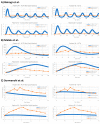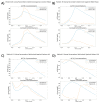VeVaPy, a Python Platform for Efficient Verification and Validation of Systems Biology Models with Demonstrations Using Hypothalamic-Pituitary-Adrenal Axis Models
- PMID: 36554152
- PMCID: PMC9777964
- DOI: 10.3390/e24121747
VeVaPy, a Python Platform for Efficient Verification and Validation of Systems Biology Models with Demonstrations Using Hypothalamic-Pituitary-Adrenal Axis Models
Abstract
In order for mathematical models to make credible contributions, it is essential for them to be verified and validated. Currently, verification and validation (V&V) of these models does not meet the expectations of the system biology and systems pharmacology communities. Partially as a result of this shortfall, systemic V&V of existing models currently requires a lot of time and effort. In order to facilitate systemic V&V of chosen hypothalamic-pituitary-adrenal (HPA) axis models, we have developed a computational framework named VeVaPy-taking care to follow the recommended best practices regarding the development of mathematical models. VeVaPy includes four functional modules coded in Python, and the source code is publicly available. We demonstrate that VeVaPy can help us efficiently verify and validate the five HPA axis models we have chosen. Supplied with new and independent data, VeVaPy outputs objective V&V benchmarks for each model. We believe that VeVaPy will help future researchers with basic modeling and programming experience to efficiently verify and validate mathematical models from the fields of systems biology and systems pharmacology.
Keywords: HPA axis; Major Depressive Disorder; Python; Verification & Validation; differential equations model; stress test.
Conflict of interest statement
The authors declare no conflict of interest.
Figures












Similar articles
-
The stress system in the human brain in depression and neurodegeneration.Ageing Res Rev. 2005 May;4(2):141-94. doi: 10.1016/j.arr.2005.03.003. Ageing Res Rev. 2005. PMID: 15996533 Review.
-
Mathematical analysis of the role of pituitary-adrenal interactions in ultradian rhythms of the HPA axis.Comput Biol Med. 2021 Aug;135:104580. doi: 10.1016/j.compbiomed.2021.104580. Epub 2021 Jun 15. Comput Biol Med. 2021. PMID: 34166879
-
Modeling the Sex Differences and Interindividual Variability in the Activity of the Hypothalamic-Pituitary-Adrenal Axis.Endocrinology. 2017 Nov 1;158(11):4017-4037. doi: 10.1210/en.2017-00544. Endocrinology. 2017. PMID: 28938475 Free PMC article.
-
Hypothalamic-pituitary-adrenal and hypothalamic-pituitary-gonadal axes: sex differences in regulation of stress responsivity.Stress. 2017 Sep;20(5):476-494. doi: 10.1080/10253890.2017.1369523. Epub 2017 Aug 31. Stress. 2017. PMID: 28859530 Free PMC article. Review.
-
Corticotropin-releasing hormone and the hypothalamic-pituitary-adrenal axis in psychiatric disease.Handb Clin Neurol. 2014;124:69-91. doi: 10.1016/B978-0-444-59602-4.00005-8. Handb Clin Neurol. 2014. PMID: 25248580 Review.
Cited by
-
Mathematical Modeling in Systems Biology.Entropy (Basel). 2023 Sep 25;25(10):1380. doi: 10.3390/e25101380. Entropy (Basel). 2023. PMID: 37895501 Free PMC article.
-
Applying neural ordinary differential equations for analysis of hormone dynamics in Trier Social Stress Tests.Front Genet. 2024 Aug 1;15:1375468. doi: 10.3389/fgene.2024.1375468. eCollection 2024. Front Genet. 2024. PMID: 39149587 Free PMC article.
-
Recent advances in culture medium design for enhanced production of monoclonal antibodies in CHO cells: A comparative study of machine learning and systems biology approaches.Biotechnol Adv. 2025 Jan-Feb;78:108480. doi: 10.1016/j.biotechadv.2024.108480. Epub 2024 Nov 19. Biotechnol Adv. 2025. PMID: 39571767 Review.
References
-
- Thacker B.H., Doebling S.W., Hemez F.M., Anderson M.C., Pepin J.E., Rodriguez E.A. In: Concepts of Model Verification and Validation. Schaller C., editor. US Department of Energy, Los Alamos National Laboratory; Los Alamos, NM, USA: 2004. Report No.: LA-14167-MS;
-
- IWGFR . Specialists’ Meeting on Predictions and Experience of Core Distortion Behaviour 1–4 October 1984. International Atomic Energy Agency; Wilmslow, UK: 1984.
-
- Nakagawa M. Verification and Validation of Core Mechanical Performance Code ARKAS with IAEA Benchmark Problems, (II) J. Nucl. Sci. Technol. 1993;30:389–412. doi: 10.1080/18811248.1993.9734497. - DOI
-
- Hohne T., Kliem S., Bieder U. IAEA CRP benchmark of ROCOM PTS test case for the use of CFD in reactor design using the CFD-Codes ANSYS CFX and TrioCFD. Nucl. Eng. Des. 2018;333:161–180. doi: 10.1016/j.nucengdes.2018.04.017. - DOI
-
- Schwer L.E. An overview of the PTC 60/V&V 10: Guide for verification and validation in computational solid mechanics. Eng. Comput. 2007;23:245–252. doi: 10.1007/s00366-007-0072-z. - DOI
Grants and funding
LinkOut - more resources
Full Text Sources

